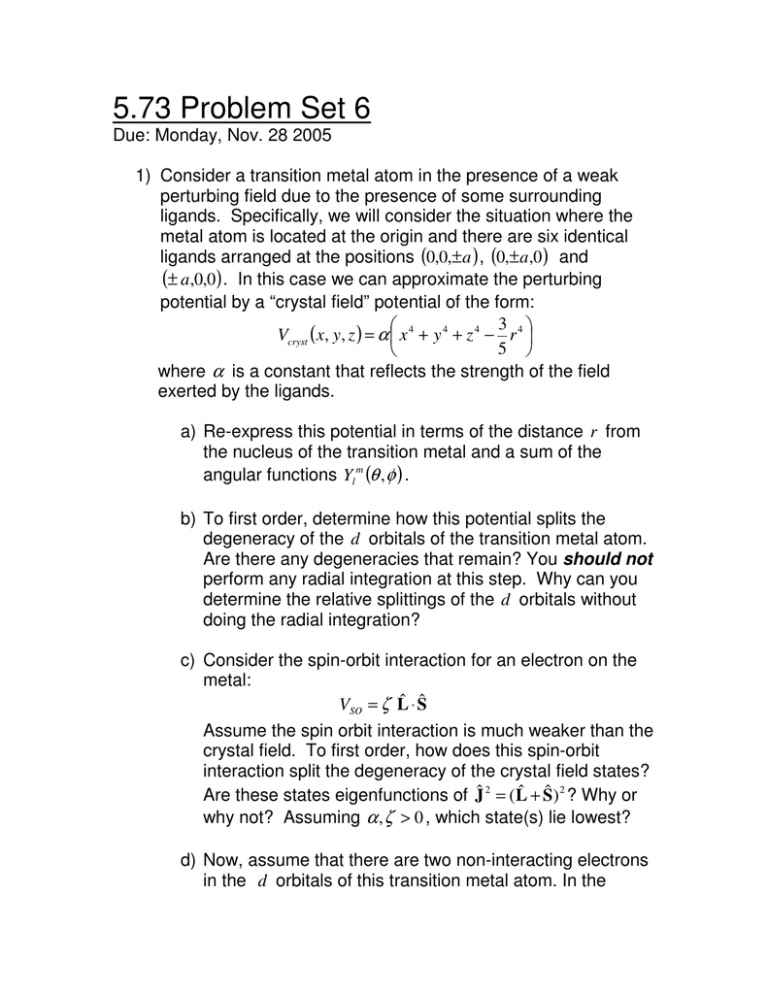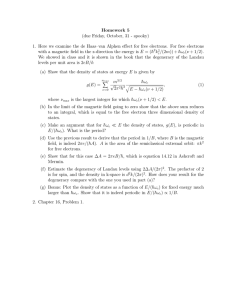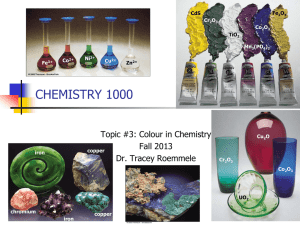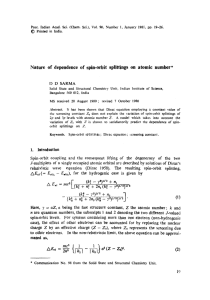5.73 Problem Set 6
advertisement

5.73 Problem Set 6 Due: Monday, Nov. 28 2005 1) Consider a transition metal atom in the presence of a weak perturbing field due to the presence of some surrounding ligands. Specifically, we will consider the situation where the metal atom is located at the origin and there are six identical ligands arranged at the positions (0,0,± a ) , (0,± a ,0 ) and (± a,0,0) . In this case we can approximate the perturbing potential by a “crystal field” potential of the form: 3 Vcryst ( x, y, z ) = α x 4 + y 4 + z 4 − r 4 5 where α is a constant that reflects the strength of the field exerted by the ligands. a) Re-express this potential in terms of the distance r from the nucleus of the transition metal and a sum of the angular functions Yl m (θ , φ ) . b) To first order, determine how this potential splits the degeneracy of the d orbitals of the transition metal atom. Are there any degeneracies that remain? You should not perform any radial integration at this step. Why can you determine the relative splittings of the d orbitals without doing the radial integration? c) Consider the spin-orbit interaction for an electron on the metal: VSO = ζ Lˆ ⋅ Sˆ Assume the spin orbit interaction is much weaker than the crystal field. To first order, how does this spin-orbit interaction split the degeneracy of the crystal field states? ˆ + Sˆ ) 2 ? Why or Are these states eigenfunctions of Jˆ 2 = ( L why not? Assuming α , ζ > 0 , which state(s) lie lowest? d) Now, assume that there are two non-interacting electrons in the d orbitals of this transition metal atom. In the presence of the crystal field (but neglecting spin-orbit interactions) and assuming α > 0 , what is the lowest energy the two electrons can have? What is the degeneracy of this energy? What are the possible 2 eigenvalues of S 2 = Sˆ 1 + Sˆ 2 for the degenerate states? ( ) 2. Consider a set of orthonormal one particle orbitals φi . For each of the following many-particle states, determine: the number of particles involved, whether the state is appropriate for describing Fermions, the total spin (i.e. the eigenvalue of Ŝ 2 ) and whether or not the state is a single determinant. a. φ1 ↑ φ1 ↑ φ1 ↑ − φ2 ↑ φ2 ↑ φ2 ↑ b. φ1 ↑ φ1 ↓ φ2 ↑ − φ1 ↑ φ2 ↑ φ1 ↓ − φ1 ↓ φ1 ↑ φ2 ↑ + φ1 ↓ φ2 ↑ φ1 ↑ − φ2 ↑ φ1 ↓ φ1 ↑ + φ2 ↑ φ1 ↑ φ1 ↓ φ1 φ2 φ3 − φ1 φ3 φ2 − φ2 φ1 φ3 + ↑ ↑ ↑ c. φ φ φ − φ φ φ + φ φ φ 3 2 1 3 1 2 2 3 1 1 i φ1φ1φ2 − φ1φ1φ2 d. 2 2 3. We’re going to consider two electrons in a Harmonic potential. The position and momentum of electron 1 (2) will be denoted by qˆ1 , pˆ 1 ( qˆ2 , pˆ 2 ). First, we will assume that the electrons do not interact. Thus the Hamiltonian is 2 2 pˆ 1 1 pˆ 2 2 2 2 ˆ H0 ≡ + 2 mω qˆ1 + + 12 mω 2 qˆ2 2m 2m a. Write down the lowest singlet and triplet energy eigenstates for the two non-interacting electrons in this potential. What are the energies of these two sates? b. Now, assume the electrons repel each other via an interaction: 2 V ≡ e(qˆ1 − qˆ2 ) . Treat this interaction as a perturbation and determine the first order changes in the singlet and triplet energies from part a.






